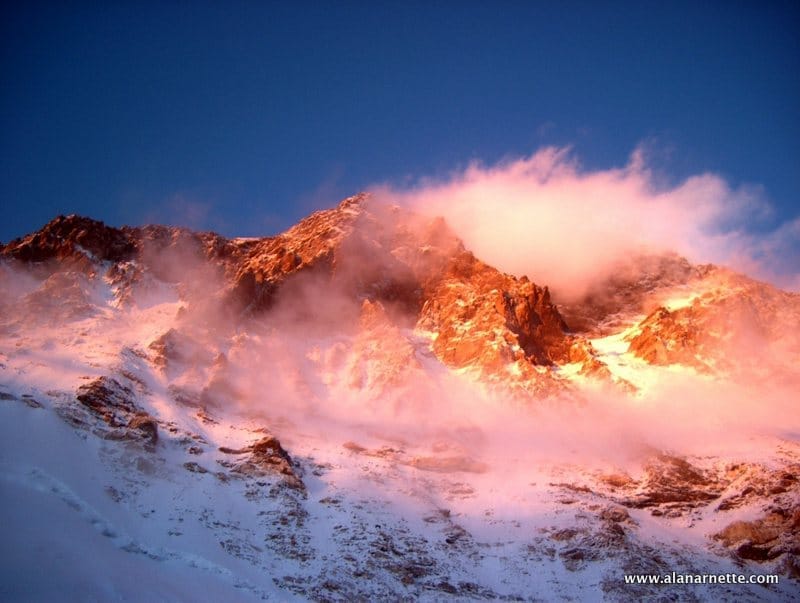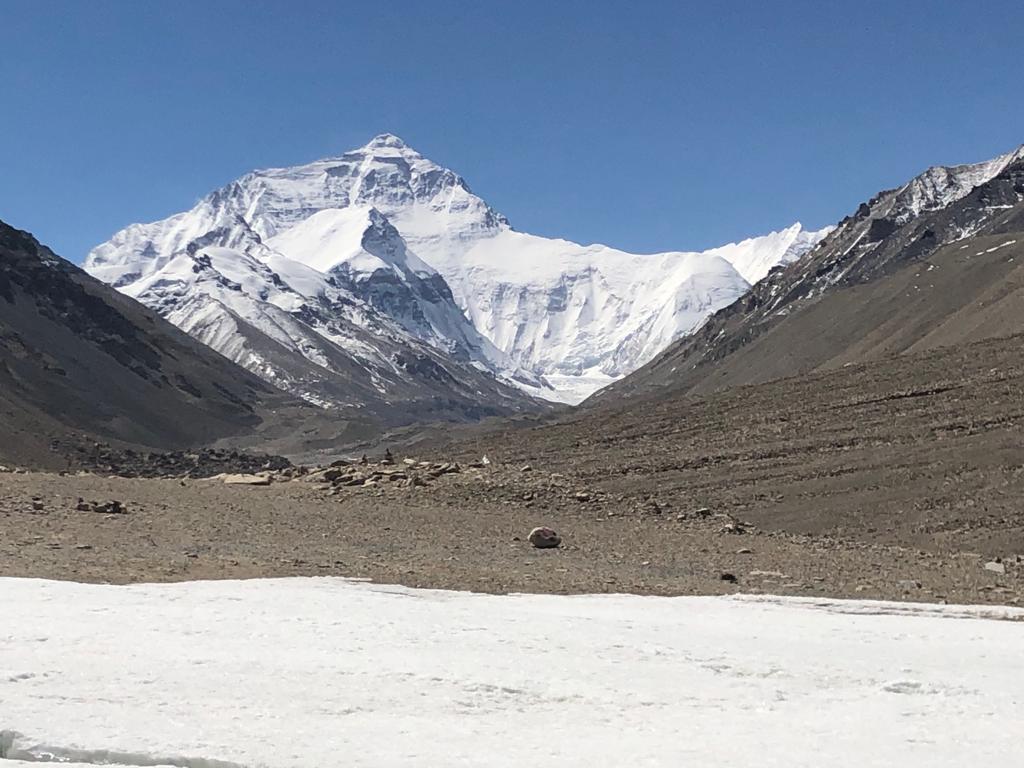
Who were the first climbers to summit Everest continues to be a mystery that enthralls Everest followers and borders on obsession for a few historians.
The key question that remains is; can it be proven that George Mallory and Sandy Irvine summited Mt. Everest in 1924, or not? You see, Mallory’s body has been found but not Sandy Irvine, view and he had a camera.
Without proof, the world will always accept that Sir Edmund Hillary and Tenzing Norgay were the first to summit in 1953, 29 years later.
Everest Historian Tom Holzel, has new data on where Irvine, and perhaps the camera, might be found and is looking for partners to solve the mystery once and for all.
Before we take a look at this effort, a tiny bit of background of the north.
The north side of Everest is steeped in history with multiple attempts throughout the 1920?s. The first attempt was by a British team in 1921 when Mallory led a small team becoming the first known human to set foot on the mountain’s flanks by climbing up to the North Col (7003m). The second expedition in 1922 reached 27,300? before turning back, and was the first team to use supplemental oxygen – an unknown tool at that time.
But it was the 1924 Mallory and Irvine effort that was most notable as a climber was sighted on the high summit ridge but then disappeared. Mallory’s body was found in 1999 but there was no proof that he died going up or coming down thus the importance of finding the camera and potential photos of a summit.
The first summit of Everest from Tibet was by a Chinese team on May 25, 1960. Nawang Gombu (Tibetan) and Chinese Chu Yin-Hau and Wang Fu-zhou, who is said to have climbed the Second Step in his sock feet, claimed the honor.
However without a summit photo, many doubted the summit claim. In 1975, a successful summit was again claimed by the Chinese when the ladder on the Second Step was installed.
With the mystery of who was first dominating Everest gossip for almost a century, teams have looked in vain for positive proof of a 1924 summit. There have been valiant efforts and vague clues throughout the years.
In 1933, Irvine’s wooden ice axe was found in the fall line of the climber’s last known route. A Chinese porter reported seeing an “an english dead” in 1960 but there were no pictures.
Then in 1999, a team led by IMG founder Eric Simonson conducted a serious search. Conrad Anker found Mallory’s body on the north side below the Chinese reported location. Neither Irvine’s body nor the camera was located. Simonson returned in 2001 to look for the camera, without success. It was the classic needle in the haystack search complicated by snow cover.
While the discovery of Mallory’s body created excitement throughout the climbing world, it did not provide any evidence of a summit. In fact it just fueled the speculation. One of the members of that 1999 expedition, Jake Norton wrote a very interesting view on the summit question on his blog in 2010 making the case that they did summit.
But no one knows for sure and the camera might be able to close the case.
Tom Holzel, who conducted a thwarted search expedition in 1986, took a new approach to locating the camera using two images; one from a photo taken in 1933 and another taken in 1984 from a SwissPhoto, AG, Learjet flying over Everest. This last image was very high-resolution.
Holzel used imaging technology to compare the photographs and discovered that the location of an ice ax marking a certain fall of the two climbers, was misplaced by 60 yards. Everyone was looking in the wrong place! Following the new line, he identified what he calls an “oblong blob”. The blob is near where the Chinese porter reported his sighting in 1975.
Holzel strongly believes this is Irvine who is thought to have been carrying the Vest Pocket Kodak camera when he and Mallory disappeared.
Now Holzel wants to be certain by taking a new image with another flyover using the latest advancements in photography, but he needs $10,000. Once he proves the location of Irvine, he wants to continue the search with a small team that would include Thom Pollard and Jake Norton of the 1999 expedition.
Kodak Scientists have consulted with them on the project so if they find the camera, they have processes on how to handle it to prevent further damage.
Tom was kind enough to do yet another interview with me. Mind you, he has been interviewed extensively and asked almost every question imaginable so we explored his latest thoughts and case for the flyover.
AA: Tom, you’ve been after the Mallory & Irvine (M&I) mystery for quite a while now. And general opinion of what really happened to them is still all over the map. Are we any closer to finding out how far they actually got?
TH: I think so, but the conclusion we are being driven to is not what most Mallory &Irvine fans want to hear—and I’m the one at fault. In 1971 in Mountain Magazine #17 I did an analysis of all the known climbs on Mt Everest—69 segments in all—to plot how much of a difference the use of oxygen made on climbing speed. And because M & I were using oxygen, it looked to me like their chances of success had been grossly underestimated. The pre WW-II British leaders thought any theoretical advantage was nullified by the added weight. The chart showed a marked speed advantage for using oxygen.
AA: And how were those calculations used?
TH: It let us estimate how fast M & I would have climbed on June 6th. However, it also showed a dramatic drop in climbing speed the higher one went—which was an unknown factor to the pre-WW-II British climbers. So M & I weren’t aware of it either.
AA: They climbed slower as they went higher even with oxygen. What does this prove?
TH: It tells us several things. First, it tells us why Mallory wrote to Photographer John Noel to be on the look-out for them near the Second Step by as early as 8am. It’s not because he was going to get up a 3 in the morning; rather, he must have extrapolated from their rapid climb up from the North Col to C-6 using only ¾ of a single tank of gas each, or 3 hours, to achieve a gain of 3700 vertical feet. That’s really stoking, but in the same ball park as Finch and Bruce climbed the same terrain in 1922 also using oxygen.
When Eric Simonson found one of the 1924 bottles, we learned that they “only” achieved at climb rate of 275 ft/hr. Excellent time, by the way, but way less than they had assumed they would achieve based on their previous two days. Even had Mallory extrapolated that speed, he would have realized that the climb to the summit from the First Step—another 1000 vertical feet with the three hours of gas they had remaining was out of the cards for the both of them.
AA: Is that where you got the idea that Mallory might have taken Irvine’s remaining oxygen?
TH: Right. It solved two major problems. The climb up to the First Step is a slog but technically easy. You put one foot in front of the other. After that you have a tough choice: attack the traverse to the Second Step and the Step itself with its horrendous exposure and lack of protection, or sidle out along the treacherously slippery down-sloping tiles of the Great Couloir route. Mallory might have felt he could do it, but he knew that dragging Irvine along was an unacceptable escalation of the risk to them both.
AA: I would think Mallory might just send Irvine back and continue alone using the available oxygen for himself.
TH: Not quite. I think he did exactly what Norton and Somervell did a few days earlier: Somervell sat down and waited to see how far Norton could get up the Great Couloir. When exhaustion slowed Norton to a crawl, he turned back and they descended more or less together.
AA: So when Mallory gave up and came back to pick-up Irvine, this is where you have the two climbing the First Step?
TH: Yes. Except that Jim Wickwire makes the excellent point that two climbers coming down from a grueling effort would never make a such strenuous detour. And he’s right. But we know that at least one person did climb the step. Odell saw that clearly. That’s what gave me the idea of Mallory continuing—probably via the Norton Route into the Great Couloir– while Irvine rested. When Mallory got back from his failed effort to breech the Second Step escarpment, he was by then thoroughly exhausted. But not Irvine.
Irvine, who had been waiting around, suggested they climb to the top of the First Step to at least get some photographs of the NE Ridge up to and beyond the Second Step. Mallory followed along and the two were spotted crossing the flat snowy patch at the base of the step by Odell. But Mallory gave up and let Irvine clamber to the top. That’s who Odell saw break skyline—only one person—and I’m suggesting that was Irvine. Then Irvine climbed down and the two began a routine return to C-6—when they were hit by a fierce snow squall.
AA: Now you claim to have discovered Irvine’s exact location. A lot of other climbers believed they knew where Irvine must lie…
TH: …but none of those locations have panned out. So let’s someone try my location.
AA: Which is where? And what’s your evidence?
TH: My evidence is still circumstantial. Strongly circumstantial, but the aerial photographs we analyzed do not have the resolution in the shadows where I claim Irvine lies to resolve a human body.
AA: And that evidence is?
TH: First, we know an accident occurred where the ice ax was found in 1933. Suggestions that the ice ax was put down when they still had a major snow field to climb is simply the most far-out excuse to try to put them on top. No one in climbing history has ever left his ice ax behind for any reason. Thus, it marks the point of an accident and the likelihood is that evidence of the accident might still be near-by.
AA: But Mallory was discovered 300m lower down from the ice axe, so something else must have happened.
TH: Mallory got down there somehow. Climbing down through the Yellow Band in a fierce snow squall with broken ribs is no mean feat. But his luck ran out when he tried to glissade down the 8200m Snow Field. At first the snowpack was deep enough for him to modulate his speed with his ice ax. But then he came over lightly snow-covered rocks farther down. The adz kicked back, the pick struck him in the forehead above his right eye. No, “struck” is too mild a word—drove it with the force of a hurled lance.
But we know that Irvine didn’t fall with Mallory. We know that because, secondly, two other climbers spotted a body in the Yellow Band—Xu Jing in 1960 and Sherpa Dorji Chhiring in 1995. Both were near the end of an exhausting climb without oxygen and neither had any clear idea of where in the Yellow Band they climbed down. Hemmleb and Simonson first learned of Xu’s sighting, in 2001 but his description of location was varied and muddled by poor translation.
AA: But aren’t there lots of bodies on the North Face?
TH: Nowadays, yes. But none at all in 1960. And none in the Yellow Band in 1995.
What was not muddled was Xu’s description of the body and its lie, and a description of what Xu’s decision-making process was on his non-standard descent. Xu said when he turned down, instead of following the standard 1924-33 path (which the 1960 Chinese also took), he “took a more direct route.”
Well, when you examine the aerial photographs it is very clear what the standard route is, and the fork that looks (and is) “more direct.” So I assume that when Irvine had to continue on, he would have continued on the route they ascended by—the standard route. But Xu explicitly didn’t take that route; he turned off it at a fork just at the ice ax site that dropped quicker and then parallels the standard route some 40m lower down.
The aerial photograph shows a “red slash”—a rock slot 20m below the standard route and right at the turn of Xu’s descent—only 50 feet away. Most importantly, the location is to Xu’s right—as he said. Chhiring also descended from the First Step, and also didn’t really know the route. So, like Xu, he must have chosen what to him also appeared to be “the more direct route.”
Instead of being a vertical slot, like most of the cracks are, the “Red Slash” runs diagonally. This fits Xu’s description of “the unfortunate” that his feet pointed toward the summit.
AA: So you’ve assembled quite a few clues, all seemingly pointing to the same spot. You’ve had this information on your website, velocitypress.com, a couple of years now. Why hasn’t anyone gone to your location yet?
TH: I’ve tried to raise money for a simple search expedition. I got the BBC interested to partially fund a search, as well as a few other partial sponsors. But always too little, too late. The big boys, having been bitten a few times by dry holes now want absolute proof of the body’s location before funding a genuine look-see.
AA: So the dream continues but now based on solid imagery. The only thing lacking are funds for a flyover to photograph the exact spot, then the expedition.
TH: Yes, this is now serious history, and science. It would be a shame not to follow every lead. We are short about $10K to fund the flyover. With the latest telephoto technology, we might be able to make a major step in the search. The alternative is another expedition costing around $100K.
Best of luck Tom in finding funding for this new flyover and eventually solving the mystery once and for all. You can read much more on Tom’s website, velocitypress.com
Climb On!
Alan
Memories are Everything
[poll id=”6″]




9 thoughts on “Everest 2013: The Continuing Search for Mallory & Irvine’s Camera”
I agree, it’s a great story and I too hope that it gets solved within the next few years or so. I’m looking forward to Graham Hoyland’s book on this (The Last Hours on Everest) in which he says he’s got new evidence, too. More grist to the mill!
Good look with the Alzheimer’s’ fundraising – a very worthy cause.
Another discussion that goes round and round is; does a successful summit require a complete DECENT in combination with a successful ASCENT…..or is reaching the summit enough? I submit, it’s only half done….they may have been the first there, though I doubt it,,,,,”M” alone perhaps but I never felt that “I” was capable of the round trip. Hope he get’s the funding and finds Irvine AND, the camera of which the film can still be salvaged. And even at that, if “I” did not make the summit and “M” did, unless “M” took the camera with him and gave it BACK to “I” when they met back up….we may STILL not know the whole story!! Perhaps living this one to the ages is best?
You will be delighted to hear that at the moment Alzheimer’s disease is having a great deal of coverage both on television and in the daily newspapers here in the ( UK ). We all agree it can never have too much publicity.Today there was a feature on how to help you prepare, if you are one of the unlucky ones to be struck down with this dreadful illness. Apparently it can be hereditary and I was not aware of this.
It is wonderful to get up in the morning knowing there will be an Everest update. Thank you so much Alan for giving pleasure to so many whilst raising funds for such an important charity.Cheers Kate ( UK )
Dear Tom, there are a few points to consider.. If Odell could continue in the storm then so could have Mallory and Irvine. Mallory’s sun glasses were found in his pocket…The sighting of Odell but where… his first impression as he recorded was ‘ saw M and I nearing the base of final pyramid’. The consensus on that is either the second step or the third step…The first step by any stretch of imagination does not fit the bill as described by Odell.. the rest follows if they were past the only difficulty that they had at 12.50…
I know of some great credible research on climbing speeds by Phil Summers and hopefully he will soon be ready to publish..
That said, the location of Irvine is still an open question.. did Wang really find Mallory or Irvine?
Mallory got 1/2 a summit even if he got to the top.
Very interesting thoughts and story. Would love it to be solved in my lifetime. Somebody else needing funding ! Cheers Kate (UK )
I agree Rolando, quite a mystery. There have been several books written about this by authors including Jochen Hemmleb, and Eric Simonson.
I agree with Lauren. It sounds like a helluva story. Jon Krakauer?
I love this story. The search for the lost camera. It is a great yarn.
Comments are closed.